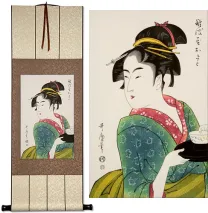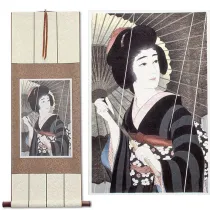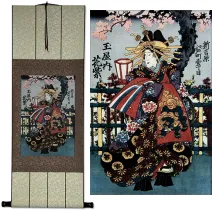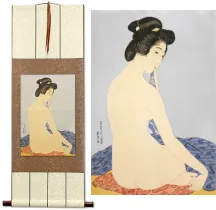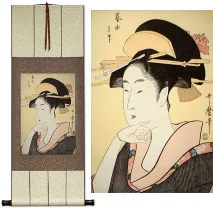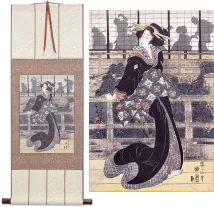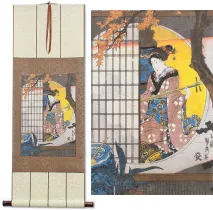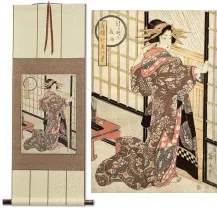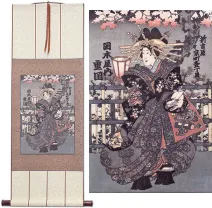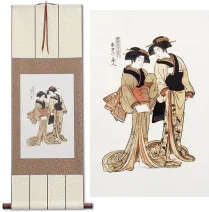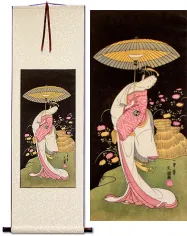Departing Spring
Japanese Woman Woodblock
Wall Scroll

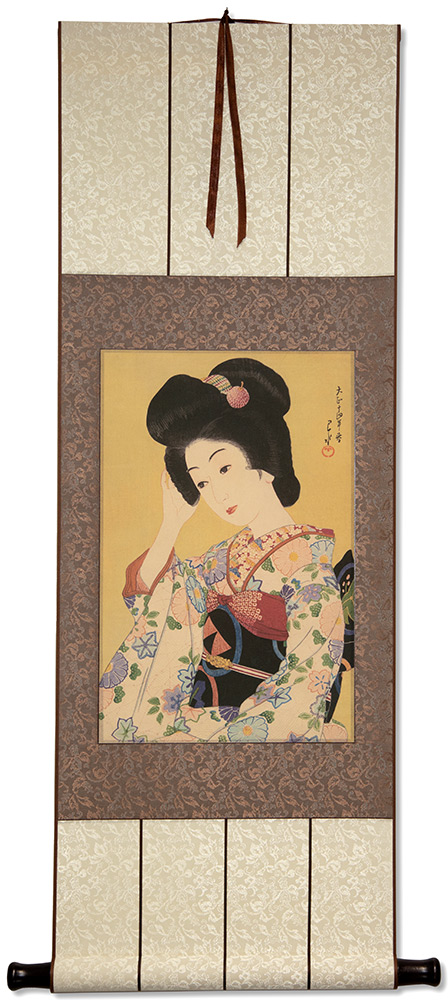
41½"
18¼"
• Delivered to you in Columbus by Dec 27th.
• Standard shipping is just $3.80 for any order.
• Limited Edition Print - I might make more.
• Handmade Wall Scroll.
• Money-Back Guarantee.

This Asian woman artwork will look great in your home or office.
Approximate Measurements
Artwork Panel: 28.3cm x 43.3cm ≈ 11" x 17"
Silk/Brocade: 37.3cm x 105.7cm ≈ 14¾" x 41½"
Width at Wooden Knobs: 46.3cm ≈ 18¼"
Information about caring for your wall scrollSee Larger Image



Departing Spring
Yuku Haru
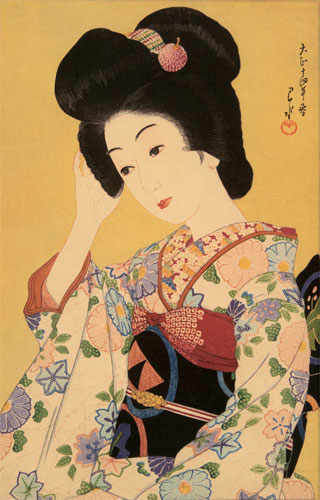
Close up view of the Asian woman artwork mounted to this silk brocade wall scroll
This is artist Hasui’s only bijgin-ga or beautiful woman portrait (he typically only did landscapes).
This artwork features a young woman adjusting her hair. Based on the artwork's title, perhaps she is about to enter the summer of her youth.
The round Watanabe seal was used until 1925 this fact helps narrow the date the original was created. The outlines of her face and hand are done with red instead of black or grey, which is highly unusual and perhaps experimental.
The title is 行く春 or "Yuku Haru" which means Departing Spring or The Fading of Spring.
Original artist: Kawase Hasui 川瀬 巴水, (1883–1957).
Publisher: Watanabe Shōzaburō.
Original woodblock was created in Japan, in 1925 (later versions were printed as late as 1931 with different seals).
More about the artist from https://www.roningallery.com/departing-spring-yuku-haru:
Regarded as a major Japanese landscape artist of the 20th century, Hasui Kawase’s prints are characterized by their serenity of mood and flawless composition. Born Bunjiro Kawase in Tokyo, Hasui Kawase was the son of a silk braid merchant. He began his artistic career studying Japanese-style painting with Kiyokata, as well as Western-style at the Hakubakai. His talent was clear, exhibiting in the Tatsumi Exhibition of Painting at age 19. However, soon after seeing Shinsui’s series Eight Views of Lake Biwa, Hasui turned his attention to woodblock printing in 1919. Shozaburo Watanabe was the first to recognize his artistic genius and Hasui Kawase soon became the most popular artist working for this prestigious publisher. Hasui traveled widely in Japan and his subjects consisted mostly of his surroundings. These Japanese landscape prints are based on small, quick sketches and watercolors taken from nature. Unfortunately, during the earthquake of 1923, all of his woodblocks and over 200 sketches were destroyed. The works that predate this event are extremely scarce and in great demand today. Undaunted, Hasui continued to produce his landscape prints. In 1956, the Japanese government’s Committee for the Preservation of Intangible Cultural Heritage designated Hasui's Zojo Temple in Snow and the documentation of its production as Intangible Cultural Treasures, the greatest artistic honor in postwar Japan. All of his prints are signed “Hasui” usually with a variety of red seals reading “sui.” Though Watanabe published the majority of Hasui Kawase’s prints, Doi, Kawaguchi, Sakai, and others published some designs as well.
About Real Japanese Woodblock Prints
Woodblock printing, often considered the precursor to the modern printing press, was first developed in China and later brought to Japan, where artists refined the technique into a unique art form. In Japan, these prints are called 木版畫 ("Moku Hanga"). Most were created during the Edo period (1603–1867), though production continued into the early 20th century.
Japanese artists would first create a "template painting" depicting scenes of daily life, including women washing clothes, men writing poetry, samurai battles, and occasionally more dramatic subjects. These template images, known as 浮世絵 (Ukiyo-e, or "Floating World"), were then carved into wood by skilled artisans. Another specialist applied wet ink or pigments to the carved blocks, and a sheet of handmade paper was pressed on to create the final print. This collaborative process produced vibrant, detailed artworks much faster than hand-painting hundreds of copies.
About This Reproduction
Original Japanese woodblock prints from the Edo period can sell for $800 to $20,000. Our prints are high-quality reproductions, crafted to capture the look and feel of the originals, though experts will recognize them as reproductions.
We use authentic handmade kozo (mulberry) paper—the same paper Japanese printmakers used centuries ago. Archival, UV-resistant pigment inks ensure long-lasting color, with laboratory testing showing up to 95 years of fade-free enjoyment if kept out of direct sunlight. Each reproduction is carefully color-corrected and restored, bringing the Edo period artwork to life for your wall.

Photographer Jeremy Cowart and the Canon imagePROGRAF PRO-2000 giclée printer used to create these reproductions.
Printing on delicate handmade paper is challenging. After testing multiple high-end printers, we found the Canon imagePROGRAF PRO-2000 delivers the precision and quality needed, using 12 archival inks and 18,432 nozzles. Each print is then sent to our Beijing workshop, where it is mounted into a handmade wall scroll, ready-to-hang without the need for expensive framing, giving your piece an authentic Japanese look.
Because the original artist has long passed, these works are public domain. In some cases, we license high-resolution scans of original prints, or even scan 200-year-old originals ourselves. This dedication ensures you receive a stunning Japanese woodblock print reproduction at an affordable price, making traditional Asian art accessible to everyone.
Want a custom wall scroll or unique print size? Just contact us!
We can print larger sizes, choose your preferred paper texture, and select silk brocade colors. Ready-to-frame prints can ship in days, while custom wall scrolls may take several weeks. Either way, the result is a truly one-of-a-kind piece of Japanese art.
This item was listed or modified
Aug 24th, 2023
